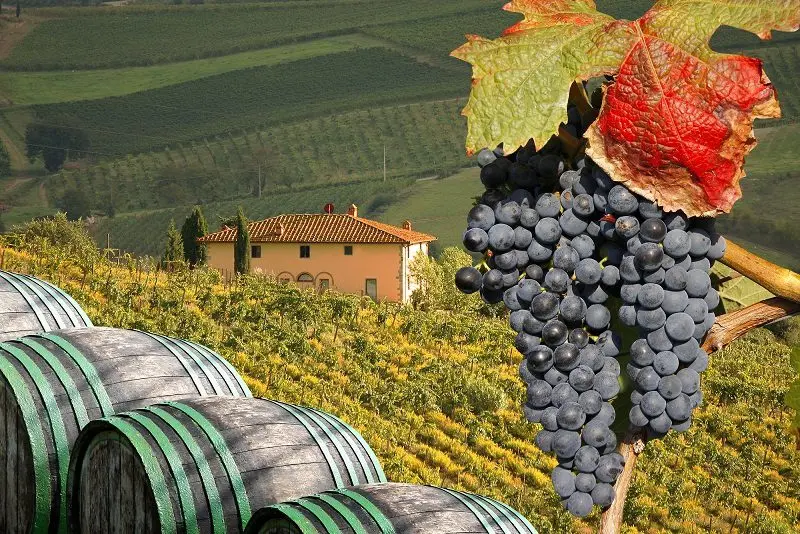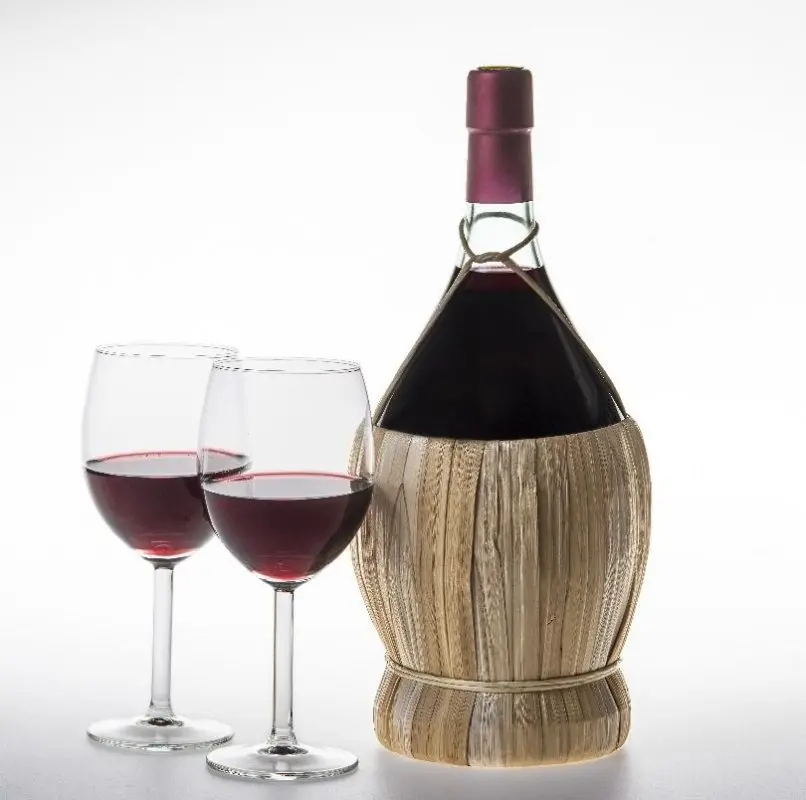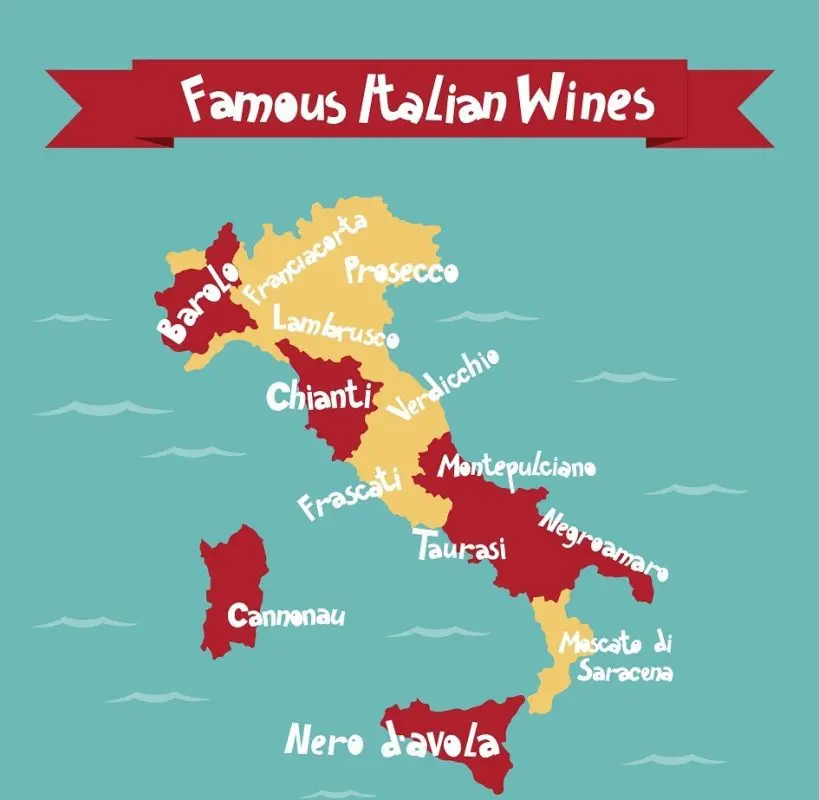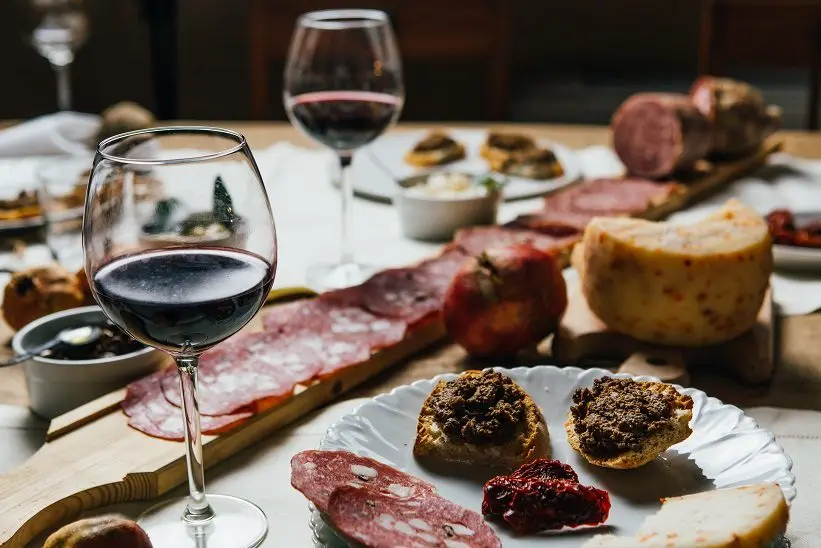Contents
Chianti is a red dry wine from Tuscany with a strength of 11,5-12,5%, named after the mountains in the South of Florence, a visiting card of Italian winemaking. It has a vibrant ruby color and a slightly astringent taste. Classic Chianti is made exclusively from Sangiovese grapes, in other variations blending with Cabernet, Merlot, Colorino and other varieties is possible, but the share of Sangiovese must be at least 75%.
The Chianti wine region is divided into zones: Classico, Colli Aretini, Colli Fiorentini, Colli Senesi, Colline Pisane, Montalbano and Rufina (“Colli” means “hills” in Italian).

The most famous zones are Chianti Classico and Rufina, the rest of the wines are sold most often under the name Chianti. The bouquet of Chianti wine is a combination of tart overtones, delicate aroma of wild berries, refreshing cherry sourness and violet nuances. (c) Gunel Asadullayeva, sommelier.
Baron Giovanni Ricasoli-Firidolfi, president of the consortium of Chianti producers, claims that the real Chianti Classico gives off pure flower honey and freshly baked rustic bread, even noble wine should be slightly bitter.

Today, Chianti wines, like any other, are supplied to the market in thick-walled standard-shaped bottles. But earlier, when Chianti was the drink of the poor, and not the masters, it was poured into characteristic pot-bellied bottles of thin glass (called “fiasco”), and so that the containers would not break on the road, the vessels were braided with straw and bast.

It is believed that real Chianti must have a recognizable emblem – a black rooster in a red circle. In fact, this symbol is just a sign of the Chianti Consortium, that is, evidence that the wine producer is part of a trade association created to promote the product on the market. The absence of a bird does not betray a fake at all – on the contrary, perhaps this winemaker is so good that it does not need additional advertising.
But what is really important is the abbreviation DOCG (Denominazione di Origine Controllata e Garantita) – a guarantee that the wine meets the highest quality standards and was created according to the technology prescribed by law.
The mystery of the black rooster
The rooster appeared on the neck of the Chianti for a reason. According to legend, this bird helped the Florentines win a territorial dispute with their neighbors, the inhabitants of Siena, and the grateful Italians immortalized the morning singer in this way – especially since the historical zone of Chianti just extends between Florence and Siena.
It was like this: the arguing parties decided that with the first cock’s cry, two horsemen would leave the cities towards each other, and where they met, the border would pass. Either the cunning Florentines did not feed their bird so that it woke up and sang as early as possible, or the rooster himself hurried to greet the sun, but the Sienese chevalier jumped on his horse 20 minutes later than the Florentine colleague. The result is still visible on the map of Italy: in that dispute, Florence really grabbed a noble piece.

Types of Chianti
Any wine produced in the municipality of Chianti in the territory from Pisa to Tuscany and corresponding to the standards of winemaking accepted in the region can be called “Chianti”. In order not to get confused in this abundance, it is customary to focus on the following classification.
Chianti wine. This is the most uncomplicated and inexpensive wine of this category. It is usually only 75-80% Sangiovese. In the store, a bottle costs on average from 10 euros, you can drink it at dinner without waiting for a special occasion – a simple Chianti tastes good, but is neither rare nor an exquisite gourmet delicacy.
Chianti Superiore. This wine is already subject to higher requirements – it must be aged for at least 9 months, and the countdown is from January 1, after the harvest, so you can buy a young Superiore only closer to winter. It is already more expensive than a simple Chianti, it is not a shame to put a bottle of such a drink on the festive table.
Chianti Classico. Wine made in the “historical homeland” of Chianti – that very piece of land between Siena and Florence. This is a fairly large area of 70 thousand hectares, so the characteristics of Chianti Classico are highly dependent on the area. For example, wines from Catellina have a more subtle aroma, while their counterparts from Castelnuvo Berardegni have a rich spicy taste.
Chianti Classico Reserve – aged Chianti, the pinnacle of winemaking excellence and premium wine. Aged for at least 27 months, has a strength of 12.5%. Chianti Riserva is the choice of connoisseurs or those who need an exclusive wine to celebrate a significant event.
Experimental Chianti. This category includes wines made according to the winemaker’s own family recipe using personal “chips”. For example, only old Sangiovese vines or grapes exclusively from the sunny side of the hill can be used for a drink. Quality and taste depend on the manufacturer.

The best Chianti wines come from the provinces of Prato, Arezzo, Pistoia, Florence, Siena and Pisa, but ordinary wine lovers do not need to understand such subtleties, it will be enough to see the coveted DOCG marking on the excise label. Of the eight production zones, only Classico and Rufina are singled out separately, wines from other territories are usually marketed under the general name Chianti.
How and with what to drink Chianti
It is customary to drink Chianti wines from tulip-shaped glasses with a volume of 500-600 ml, filled to a maximum of a third. In such a vessel, the aroma of the drink is well revealed and preserved. The optimum serving temperature is 16-18°C.
Best of all, Chianti wine is combined with traditional Italian dishes, but it also goes well with red meat, poultry, and hard cheeses. The more expensive and better the wine, the easier it is to pick it up as an appetizer. The most expensive varieties are enjoyed without an appetizer or served in a bottle with white bread or red grapes.

Interesting facts about Chianti wine
- “Sangiovese” means “Blood of Jupiter”.
- Chianti wine is first mentioned in a 1938 document.
- Italian winemakers produce about 98 million liters of Chianti per year.
- The taste of wine depends on its terroir – a unique combination of soil, climatic conditions, grape variety and production method.
- Today, Chianti can be made from 100% Sangiovese, but a hundred years ago such wine would have been considered table wine and would have been inexpensive – the classic formula included only 70% Sangiovese, 15% Canaiolo Nero, 10% white Malvasia and 5% Colorino.
- The shelf life of Chianti is from 4 to 10 years (for Riservo), then the wine does not age nobly, but simply degrades, representing only collection interest.









